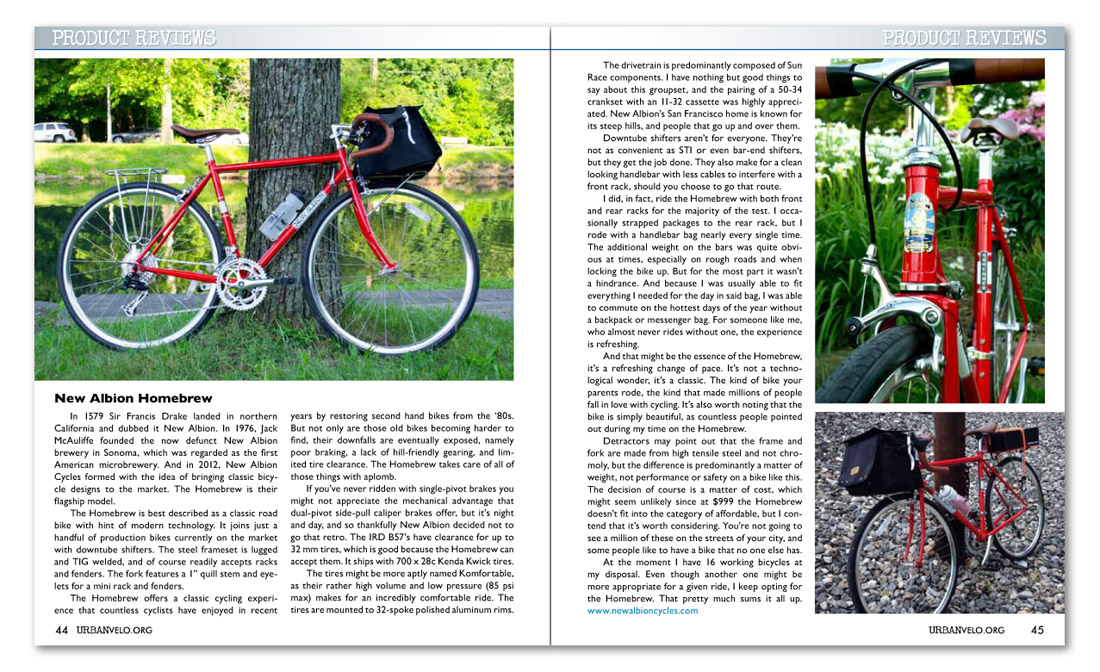


New Albion Homebrew
In 1579 Sir Francis Drake landed in northern
California and dubbed it New Albion. In 1976, Jack McAuliffe founded the now defunct New Albion brewery in Sonoma, which was regarded as the first American microbrewery. And in 2012, New Albion Cycles formed with the idea of bringing classic bicycle designs to the market. The Homebrew is their
flagship model.
The Homebrew is best described as a classic road bike with hint of modern technology. It joins just a handful of production bikes currently on the market with downtube shifters. The steel frameset is lugged and TIG welded, and of course readily accepts racks and fenders. The fork features a 1” quill stem and eyelets for a mini rack and fenders.
The Homebrew offers a classic cycling experience that countless cyclists have enjoyed in recent years by restoring second hand bikes from the ‘80s.
But not only are those old bikes becoming harder to find, their downfalls are eventually exposed, namely poor braking, a lack of hill-friendly gearing, and limited tire clearance. The Homebrew takes care of all of those things with aplomb.
If you’ve never ridden with single-pivot brakes you might not appreciate the mechanical advantage that dual-pivot side-pull caliper brakes offer, but it’s night and day, and so thankfully New Albion decided not to go that retro. The IRD B57’s have clearance for up to 32 mm tires, which is good because the Homebrew can accept them. It ships with 700 x 28c Kenda Kwick tires.
The tires might be more aptly named Komfortable, as their rather high volume and low pressure (85 psi max) makes for an incredibly comfortable ride. The tires are mounted to 32-spoke polished aluminum rims.
The drivetrain is predominantly composed of Sun Race components. I have nothing but good things to say about this groupset, and the pairing of a 50-34 crankset with an 11-32 cassette was highly appreciated. New Albion’s San Francisco home is known for its steep hills, and people that go up and over them.
Downtube shifters aren’t for everyone. They’re not as convenient as STI or even bar-end shifters, but they get the job done. They also make for a clean looking handlebar with less cables to interfere with a front rack, should you choose to go that route.
I did, in fact, ride the Homebrew with both front and rear racks for the majority of the test. I occasionally strapped packages to the rear rack, but I rode with a handlebar bag nearly every single time. The additional weight on the bars was quite obvious at times, especially on rough roads and when locking the bike up. But for the most part it wasn’t a hindrance. And because I was usually able to fit everything I needed for the day in said bag, I was able to commute on the hottest days of the year without a backpack or messenger bag. For someone like me, who almost never rides without one, the experience is refreshing.
And that might be the essence of the Homebrew, it’s a refreshing change of pace. It’s not a technological wonder, it’s a classic. The kind of bike your parents rode, the kind that made millions of people fall in love with cycling. It’s also worth noting that the bike is simply beautiful, as countless people pointed out during my time on the Homebrew.
Detractors may point out that the frame and fork are made from high tensile steel and not chromoly, but the difference is predominantly a matter of weight, not performance or safety on a bike like this. The decision of course is a matter of cost, which might seem unlikely since at $999 the Homebrew doesn’t fit into the category of affordable, but I contend that it’s worth considering. You’re not going to see a million of these on the streets of your city, and some people like to have a bike that no one else has.
At the moment I have 16 working bicycles at my disposal. Even though another one might be more appropriate for a given ride, I keep opting for the Homebrew. That pretty much sums it all up.
www.newalbioncycles.com